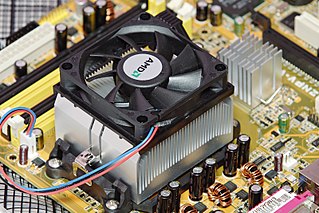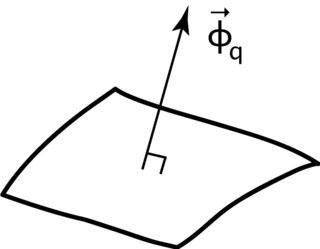The thermal conductivity of a material is a measure of its ability to conduct heat. It is commonly denoted by , , or .

Thermal insulation is the reduction of heat transfer between objects in thermal contact or in range of radiative influence. Thermal insulation can be achieved with specially engineered methods or processes, as well as with suitable object shapes and materials.
Thermal conduction is the transfer of heat internal energy by microscopic collisions of particles and movement of electrons within a body. The microscopically colliding particles, that include molecules, atoms and electrons, transfer disorganized microscopic kinetic and potential energy, jointly known as internal energy. Conduction takes place in all phases of including solids, liquids, gases and waves. The rate at which energy is conducted as heat between two bodies is a function of the temperature difference temperature gradient between the two bodies and the properties of the conductive interface through which the heat is transferred.
Newton's law of cooling states that the rate of heat loss of a body is directly proportional to the difference in the temperatures between the body and its surroundings. The law is frequently qualified to include provisos that the temperature difference is small and the nature of heat transfer mechanism remains the same. As such, it is equivalent to a statement that the heat transfer coefficient, which mediates between heat losses and temperature differences, is a constant. This condition is generally met in thermal conduction as the thermal conductivity of most materials is only weakly dependent on temperature, but it is often met only approximately in conditions of convective heat transfer, where several physical processes make effective heat transfer coefficients somewhat dependent on temperature differences. Finally, in the case of heat transfer by thermal radiation, Newton's law of cooling holds only for rather small temperature changes.
Dissipation is the result of an irreversible process that takes place in homogeneous thermodynamic systems. A dissipative process is a process in which energy is transformed from some initial form to some final form; the capacity of the final form to do mechanical work is less than that of the initial form. For example, heat transfer is dissipative because it is a transfer of internal energy from a hotter body to a colder one. Following the second law of thermodynamics, the entropy varies with temperature, but never decreases in an isolated system.
The Biot number (Bi) is a dimensionless quantity used in heat transfer calculations. It is named after the eighteenth century French physicist Jean-Baptiste Biot (1774–1862), and gives a simple index of the ratio of the heat transfer resistances inside of a body and at the surface of a body. This ratio determines whether or not the temperatures inside a body will vary significantly in space, while the body heats or cools over time, from a thermal gradient applied to its surface.

Heat transfer is a discipline of thermal engineering that concerns the generation, use, conversion, and exchange of thermal energy (heat) between physical systems. Heat transfer is classified into various mechanisms, such as thermal conduction, thermal convection, thermal radiation, and transfer of energy by phase changes. Engineers also consider the transfer of mass of differing chemical species, either cold or hot, to achieve heat transfer. While these mechanisms have distinct characteristics, they often occur simultaneously in the same system.

Thermal radiation is electromagnetic radiation generated by the thermal motion of particles in matter. All matter with a temperature greater than absolute zero emits thermal radiation. Particle motion results in charge-acceleration or dipole oscillation which produces electromagnetic radiation.

A heat sink is a passive heat exchanger that transfers the heat generated by an electronic or a mechanical device to a fluid medium, often air or a liquid coolant, where it is dissipated away from the device, thereby allowing regulation of the device's temperature at optimal levels. In computers, heat sinks are used to cool CPUs, GPUs, and some chipsets and RAM modules. Heat sinks are used with high-power semiconductor devices such as power transistors and optoelectronics such as lasers and light emitting diodes (LEDs), where the heat dissipation ability of the component itself is insufficient to moderate its temperature.
Thermoacoustics is the interaction between temperature, density and pressure variations of acoustic waves. Thermoacoustic heat engines can readily be driven using solar energy or waste heat and they can be controlled using proportional control. They can use heat available at low temperatures which makes it ideal for heat recovery and low power applications. The components included in thermoacoustic engines are usually very simple compared to conventional engines. The device can easily be controlled and maintained.

Adrian Bejan is a Romanian-American professor who has made contributions to modern thermodynamics and developed what he calls the constructal law. He is J. A. Jones Distinguished Professor of Mechanical Engineering at Duke University and author of the 2016 book The Physics of Life: The Evolution of Everything.
Thermal hydraulics is the study of hydraulic flow in thermal fluids. The area can be mainly divided into three parts: thermodynamics, fluid mechanics, and heat transfer, but they are often closely linked to each other. A common example is steam generation in power plants and the associated energy transfer to mechanical motion and the change of states of the water while undergoing this process. Thermal-hydraulic analysis can determine important parameters for reactor design such as plant efficiency and coolability of the system.

Thermal physics is the combined study of thermodynamics, statistical mechanics, and kinetic theory of gases. This umbrella-subject is typically designed for physics students and functions to provide a general introduction to each of three core heat-related subjects. Other authors, however, define thermal physics loosely as a summation of only thermodynamics and statistical mechanics.
Calvin Mackie is an American mentor, motivational speaker, and entrepreneur. He is the older brother of actor Anthony Mackie.

Heat flux or thermal flux, sometimes also referred to as heat flux density or heat flow rate intensity is a flow of energy per unit of area per unit of time. In SI its units are watts per square metre (W⋅m−2). It has both a direction and a magnitude, and so it is a vector quantity. To define the heat flux at a certain point in space, one takes the limiting case where the size of the surface becomes infinitesimally small.
Relativistic heat conduction refers to the modelling of heat conduction in a way compatible with special relativity. This article discusses models using a wave equation with a dissipative term.
In fluid dynamics through porous media, the Darcy number (Da) represents the relative effect of the permeability of the medium versus its cross-sectional area—commonly the diameter squared. The number is named after Henry Darcy and is found from nondimensionalizing the differential form of Darcy's Law. This number should not be confused with the Darcy friction factor which applies to pressure drop in a pipe. It is defined as
The contemporary conjugate convective heat transfer model was developed after computers came into wide use in order to substitute the empirical relation of proportionality of heat flux to temperature difference with heat transfer coefficient which was the only tool in theoretical heat convection since the times of Newton. This model, based on a strictly mathematically stated problem, describes the heat transfer between a body and a fluid flowing over or inside it as a result of the interaction of two objects. The physical processes and solutions of the governing equations are considered separately for each object in two subdomains. Matching conditions for these solutions at the interface provide the distributions of temperature and heat flux along the body–flow interface, eliminating the need for a heat transfer coefficient. Moreover, it may be calculated using these data.
Isothermal technology is a type of heat transfer technology, where the heat transport is mainly via thermal waves/resonances, and achieve to transfer heat isothermally.
Wang Buxuan, also known as Bu-Xuan Wang and Pu-Hsuan Wang, was a Chinese thermal physicist and engineer, considered a pioneer in the field of engineering thermodynamics in China. He established the engineering thermodynamics program at Tsinghua University in 1957 and the China Solar Power Society in 1979. He was elected an academician of the Chinese Academy of Sciences in 1980.







